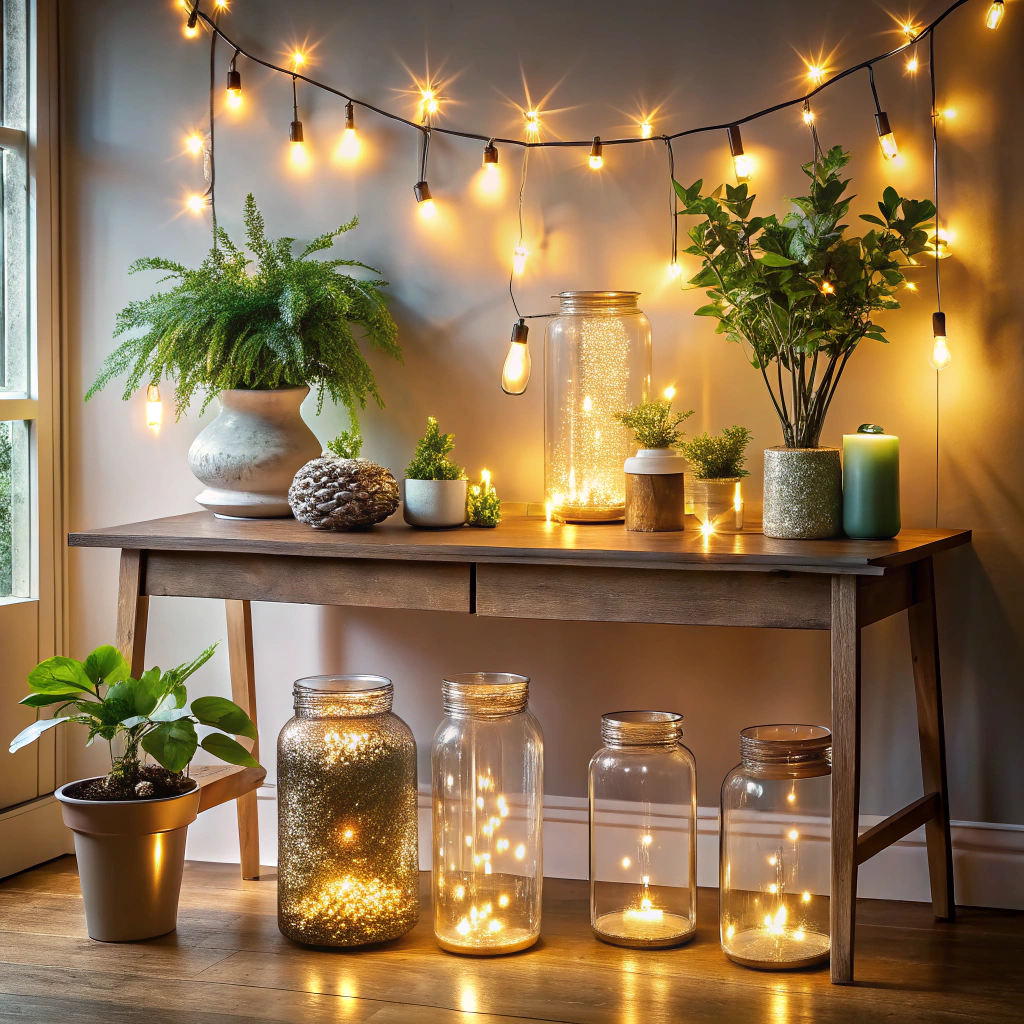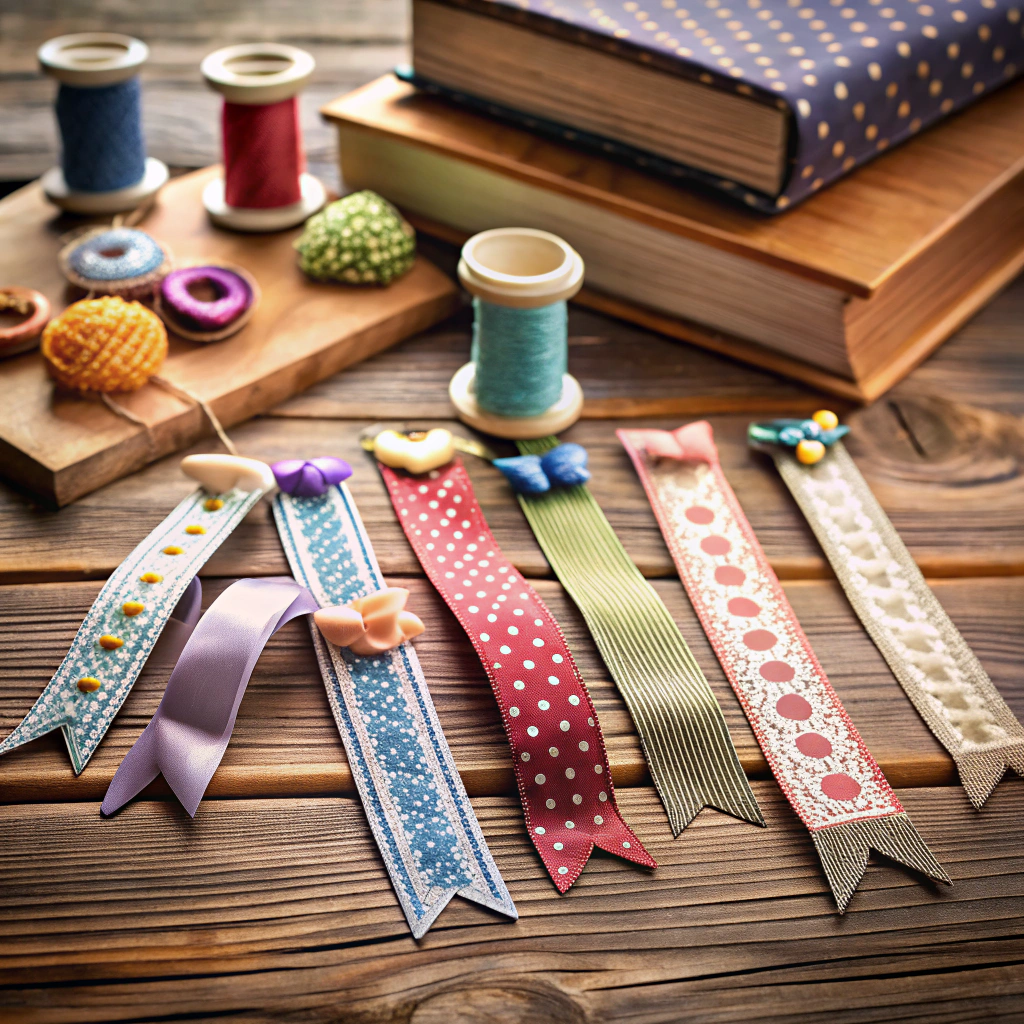Last updated on
Explore the transformative power of versatile pantry shelving systems because they can revolutionize your kitchen’s organization and aesthetics.
<strong>Key takeaways:
- Freestanding units: Portable, various sizes and styles, ideal for renters.
- Custom-built options: Tailored to specific needs, maximize space.
- Adjustable systems: Flexibility, adapt to changing storage needs.
- Pull-out shelves and drawers: Easy access, improve organization.
- Wall-mounted shelves: Use vertical space, customizable configurations.
Types of Pantry Shelving Systems
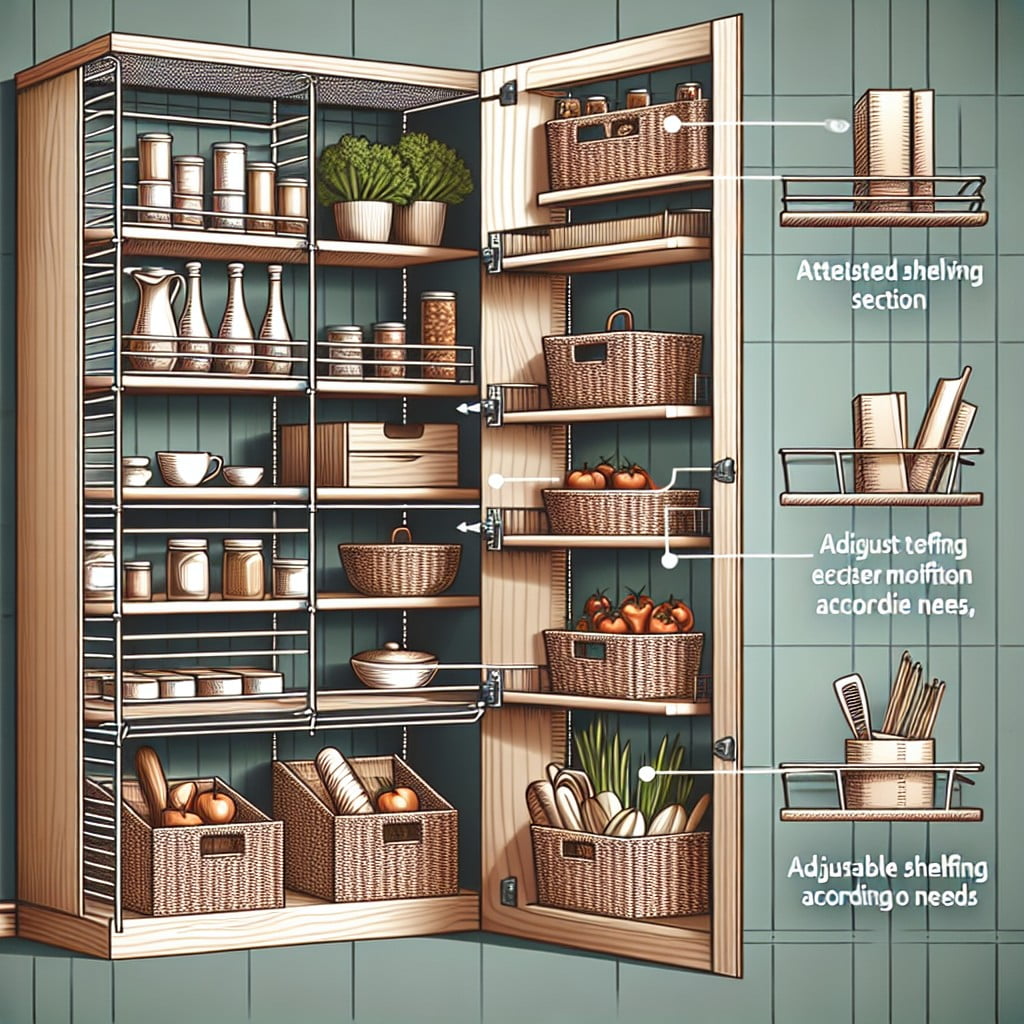
Freestanding units are popular for their portability and ease of installation. They come in various sizes and styles, fitting neatly into corners or spanning entire walls.
Custom-built options are tailored to specific needs, maximizing every inch of space with permanent fixtures that blend seamlessly with your pantry’s aesthetic.
Adjustable systems offer flexibility, allowing shelves to be moved according to the height of stored items, making it an adaptable solution for evolving storage needs.
Pull-out shelves and drawers glide out for easy access, particularly useful for reaching items stowed at the back.
Lastly, wall-mounted shelves make use of vertical space, perfect for smaller pantries, and can be arranged in a myriad of configurations to hold anything from spices to bulk goods.
Each system presents unique benefits suited to different spaces, lifestyles, and preferences.
Freestanding Shelving Units
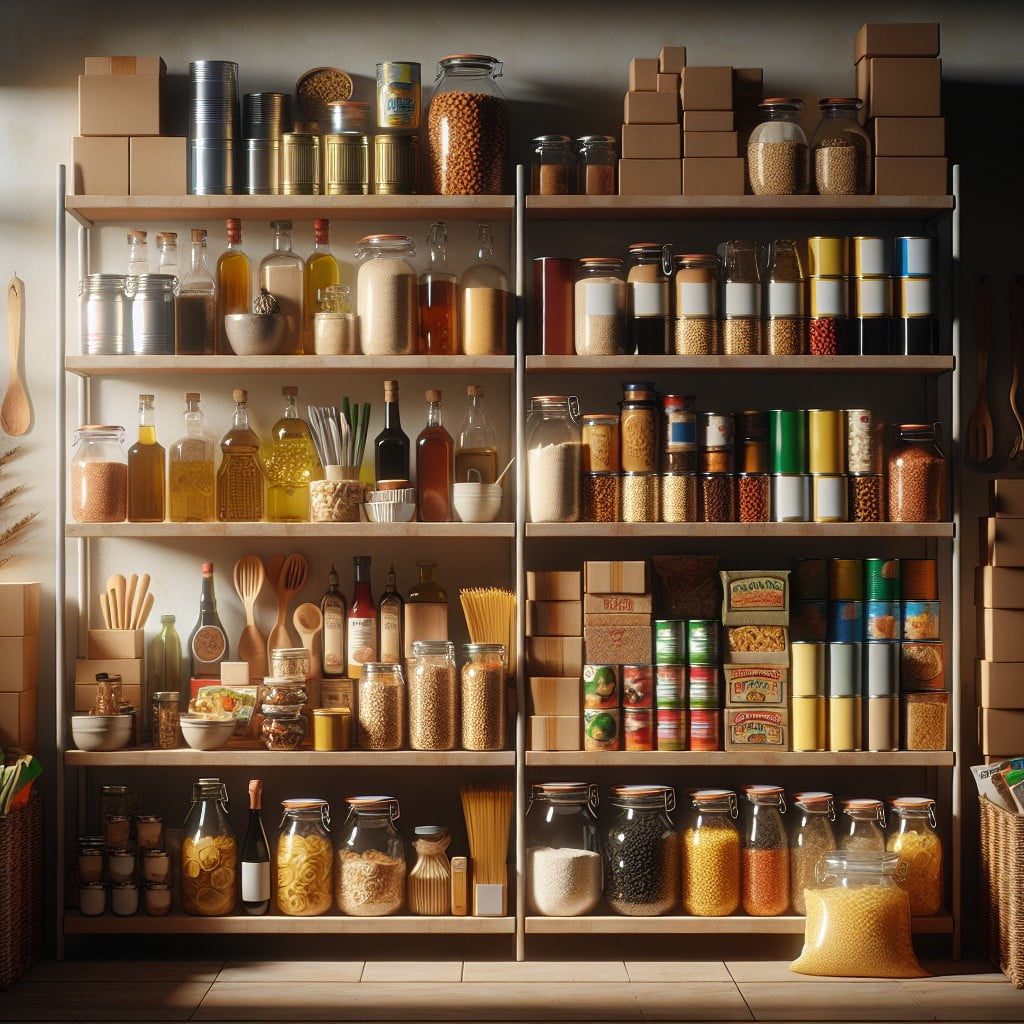
Ideal for renters or those seeking a flexible storage solution, freestanding shelving units are easily assembled and can be moved without hassle. They come in a variety of sizes to fit any pantry space. The main benefit is their versatility; you can choose from countless designs to match your home’s decor and adjust shelf heights according to your storage needs.
Here are a few points to keep in mind:
- Portability: Units can be relocated to another part of the home as requirements change.
- Assembly: Typically designed for tool-free assembly, making setup and dismantling straightforward.
- Variety: Available in different materials, including wood, metal, and plastic, to suit any aesthetic and budget.
When selecting these units, always consider the weight capacity to ensure they can support the bulk of pantry staples such as canned goods and bulk grains. Regular checks for stability are recommended, especially if you have children or pets that may interact with the unit.
Custom-Built Shelving
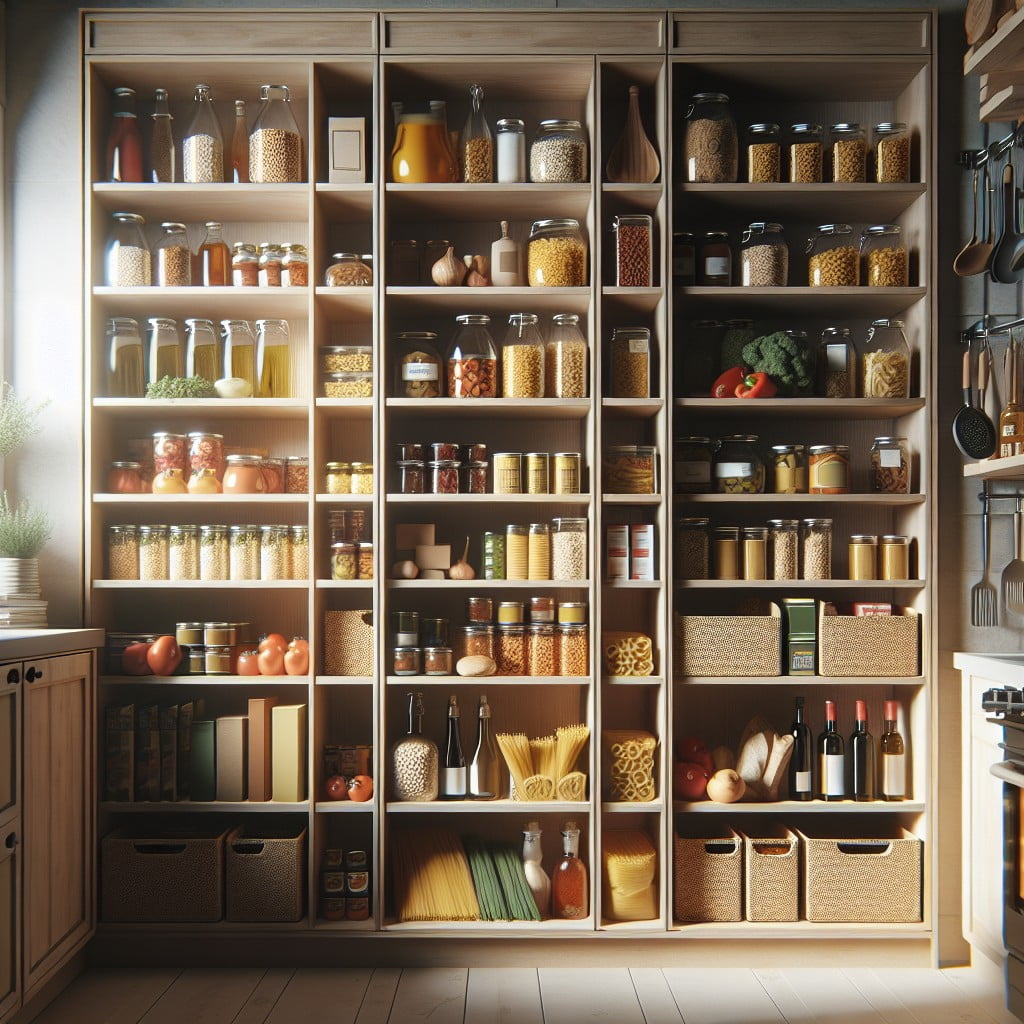
Tailored to the specific dimensions and style of your pantry, custom-built shelving transforms the space into a highly efficient storage area. This option allows you to maximize every inch, accommodating bulkier appliances or creating unique spaces for items that are frequently used.
When opting for this route, consider the following:
- Personalized Fit: A professional carpenter can assess your pantry’s layout and create shelves that fit snugly into awkward corners or under slanted ceilings, ensuring no space is wasted.
- Aesthetic Appeal: With a variety of materials and finishes at your disposal, the shelving can complement your home’s decor, providing both functionality and a touch of elegance.
- Adaptability: Have shelves designed at varying heights to store items of different sizes, or incorporate adjustable brackets, allowing for changes in storage needs over time.
- Investment Value: Although more costly than off-the-shelf options, investing in custom-built shelving can increase your home’s marketability and potential resale value.
Selecting a reliable contractor and using quality materials will ensure your custom shelves are both sturdy and long-lasting, providing an enduring solution to pantry organization.
Adjustable Shelving Systems
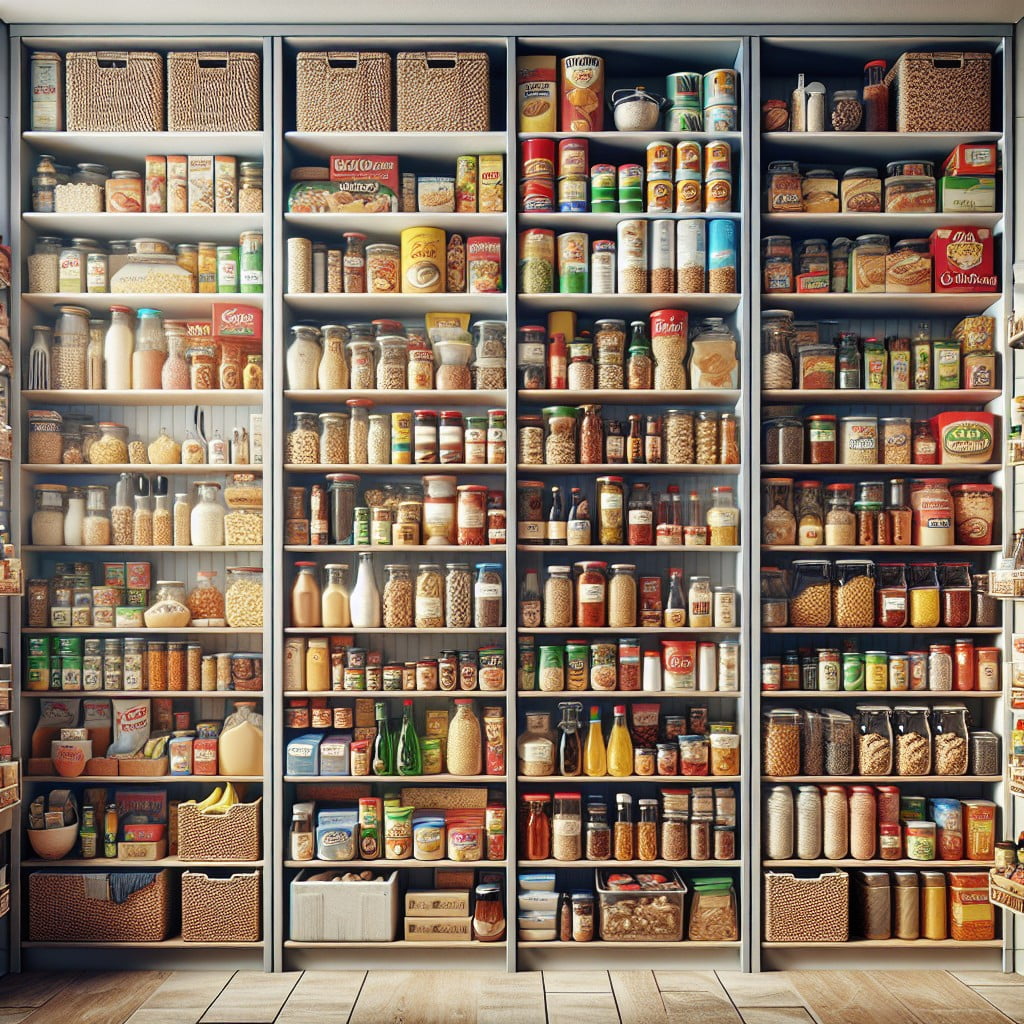
Adjustable shelving systems offer unparalleled flexibility in pantry organization, allowing you to reconfigure shelf heights to accommodate various sizes of food containers and appliances. With pegs, tracks, or slots, these systems enable quick adjustments without the need for tools.
Key Points of Adjustable Shelving Systems:
- Flexibility: Shelf heights can be easily changed to fit different items.
- Adaptability: As pantry contents change, so too can the configuration of the shelves.
- Customization: Create sections tailored to specific needs, like taller spaces for cereal boxes or closer shelves for canned goods.
- Ease of Installation: Many adjustable systems are designed for simple DIY installation, minimizing setup time.
- Variability: Options range from metal tracks with brackets to wooden units with peg holes, suiting any pantry style or budget.
Pull-Out Shelves and Drawers
Maximizing your pantry’s functionality can be achieved by incorporating pull-out shelves and drawers. These sliding compartments provide a clear view of their contents, eliminating the need to sift through items. They are particularly beneficial for storing heavy or frequently used goods, as they allow for easy access without removing other products.
Key advantages include:
- Improved access to hard-to-reach areas, ensuring no product is overlooked or wasted.
- Enhanced organization by separating pantry items, making inventory checks a breeze.
- Streamlined workflow in the kitchen, as essentials slide out to you with minimal effort.
- Better space utilization, as these can be custom-fitted to utilize every inch of available pantry space.
- Time and energy savings, drastically reducing the need to rearrange items to find what you need.
Consider width and depth when selecting pull-out shelves to ensure they accommodate large items like bags of flour or appliances. Additionally, opt for models with smooth gliding mechanisms and sturdy build quality to support the weight and frequent usage these shelves typically endure.
Wall-Mounted Shelves
Maximizing vertical space is a prime benefit of wall-mounted shelves, especially in tight pantry corners. These shelves come in various materials, such as solid wood for a classic look or metal for modern appeal. One can seamlessly adjust the height to accommodate tall items like cereal boxes or to create a compact nook for spices.
Installation is straightforward; however, it’s crucial to anchor them securely to wall studs to ensure they can hold the weight of stored goods. Adding labels or under-shelf baskets can enhance organization and accessibility, letting you find items quickly. Remember to measure your wall space before purchasing to ensure the shelves fit perfectly and complement your pantry’s layout.
Materials Used for Pantry Shelving
Choosing the right material for your pantry shelves ensures durability and aesthetic appeal. Wood, often favored for its classic look, can be stained or painted to match any interior design. It’s strong but usually requires more maintenance to prevent warping or damage from moisture.
Metal shelves offer industrial strength and are resistant to pests, making them a practical option for heavy cans and bulk items. They might look too utilitarian for some tastes, but their longevity is undeniable.
Wire shelving, a subset of metal options, promotes air circulation and helps prevent dust buildup. It’s a lightweight choice that allows for visibility from various angles, which simplifies item locating.
Plastic shelving units are economical and easy to clean, ideal for those on a budget or who desire a lightweight, rust-proof solution. They may not have the same weight capacity as other materials, but they serve well for storing light to medium-weight items.
Wood Shelving
Wooden shelves offer a classic look that can enhance the aesthetic of any pantry. They are sturdy and capable of supporting a considerable amount of weight, making them ideal for storing bulky items like cans and large bags of food.
When opting for wood, consider the following:
- Variety: Choose from solid hardwoods such as oak or maple for durability, or softer woods like pine if cost-effectiveness and ease of customization are priorities.
- Finish: Sealed or painted wood not only resists moisture and stains but can also be matched to the kitchen’s decor.
- Adjustability: Incorporate pre-drilled holes or mounting systems that allow for adjustable shelf heights, adapting to your changing storage needs.
- Support: Ensure that wooden shelves have proper brackets or support systems in place to prevent sagging over time.
- Installation: For best results, enlist a professional to ensure shelves are level and securely anchored to wall studs, especially if your pantry will hold a lot of weight.
Metal Shelving
Metal shelving offers unparalleled strength and durability for pantry storage, making it ideal for holding heavy items such as canned goods or bulk purchases. These shelves are typically made of steel or aluminum and come in various finishes including chrome, stainless steel, or powder-coated options to prevent rust and corrosion.
One major advantage is their ease of cleaning; a simple wipe down with a damp cloth can keep them looking new. Metal shelves can also be adjustable, allowing for changes in the arrangement as storage needs evolve. The open design ensures good air circulation, which is beneficial for food preservation.
Furthermore, these shelves resist pest infestations and won’t absorb odors, helping to maintain a hygienic environment for food items. They can be combined with other materials, like wooden shelf covers, to enhance aesthetics while benefiting from metal’s supportive structure. It’s crucial, however, to check the manufacturer’s weight recommendations to ensure the safety and longevity of the shelving system.
Wire Shelving
Wire shelving offers an airy design that helps maintain visibility and reduces dust accumulation. Its open structure keeps items accessible, simplifying inventory checks at a glance.
Variants with adjustable-height shelves afford flexibility, adapting to ever-changing storage needs. Easy to clean and often coated with epoxy or chrome, these shelves resist rust and corrosion, making them suitable for various environments, including those with higher moisture levels.
Despite their lightweight construction, many wire options are sturdy enough to hold substantial weight, allowing the secure storage of bulky items. For a custom fit, accessories such as shelf dividers or under-shelf baskets can be added, enhancing organization and maximizing space.
Plastic Shelving
Lightweight and cost-effective, plastic shelving is a popular option for those seeking a low-maintenance solution for their pantry. Its natural resistance to moisture makes it ideal for environments where spills are common.
The material’s versatility allows for a variety of designs, including ventilated units that prevent dust accumulation and promote air circulation around food items. Many plastic shelves are easy to assemble without tools, offering a quick setup and the flexibility to rearrange as storage needs change.
However, they may have lower weight capacities compared to metal or wood, so it’s essential to check the manufacturer’s specifications to ensure they can support the intended load. When selecting plastic shelving, opt for units made from heavy-duty, food-safe plastics to ensure longevity and safety.
Design Considerations for Pantry Shelves
Maximizing the functionality of your pantry hinges on well-thought-out design. When considering the layout, prioritize space utilization—think about how to exploit every inch, especially if you’re working with a small area.
Incorporate shelving that reaches up high, making good use of vertical spaces often overlooked. Remember that deeper shelves can hold more, but items at the back can become lost caverns of forgotten goods. Aim for a depth that balances capacity and visibility.
The weight each shelf can bear is crucial. Stocking up on heavy cans or appliances without the right support might warp or damage the shelving. Ensure that the materials and supports you choose can handle the load over time.
Lastly, consider how you interact with your pantry daily. Shelves should be accessible, with frequently used items within easy reach. Less used products can take the higher or lower shelves. Align the pantry’s design with your routine for a seamless kitchen experience.
Space Utilization
Maximizing every inch of available area is key to an efficient pantry. To achieve this:
- Employ floor-to-ceiling designs to take advantage of vertical space, enabling storage of rarely used items on higher shelves.
- Install deeper shelves at the bottom for bulky goods and shallower ones at eye level for frequently used items.
- Consider corner shelving units to make use of often wasted spaces.
- Incorporate narrow shelves on the inside of the pantry door for spices and small jars.
- Allocate specific zones for different food categories, streamlining the search process.
By thoughtfully arranging shelves to conform to the pantry’s dimensions and your storage needs, you create a system that simplifies food management and maximizes functional space.
Weight Capacity
It’s crucial to assess the items you plan to store on your pantry shelves and ensure the shelving can support their combined weight. This is not just about stability and longevity, but also about safety. Here’s what you should consider:
- Shelf Material Strength: Solid wood and metal typically hold more weight than plastic or thinner wire options.
- Brackets and Supports: The sturdier the brackets and wall anchors, the heavier the items the shelf can safely hold.
- Thickness and Depth: Deeper and thicker shelves distribute weight more effectively, reducing the risk of bowing or breaking.
- Manufacturer Specifications: Always check the manufacturer’s weight capacity recommendations to avoid overloading.
- Even Weight Distribution: Place heavier items evenly across the shelf to prevent strain on any single point.
Visibility and Accessibility
Ensuring that every item in your pantry can be easily seen and reached is essential for an efficient kitchen. Here are some points to keep in mind:
1. Transparent Containers: Using clear bins and jars allows you to quickly identify contents without moving everything around. This is especially useful for bulk items like flour or rice.
2. Labeling: Clearly label shelves and containers. This helps you find items at a glance and reminds you where to return them, which maintains order.
3. Shelf Height: Place frequently used items at eye level. Reserve higher shelves for bulk or seldom-used products.
4. Step Shelving: These tiered units let you raise cans and jars in the back row for better visibility.
5. Open Shelving: While cabinets can hide clutter, open shelving encourages you to keep things organized since everything is in plain sight.
6. Spacing Between Shelves: Adjust the height between shelves to accommodate tall items and prevent having to lay things on their sides, which can lead to spills or make them harder to grab.
7. Sliding Baskets: For lower cabinets or deep shelves, consider installing sliding baskets to pull out items, making it unnecessary to bend down or reach into the back.
By focusing on these elements, you create a pantry where ingredients and supplies are not just stored but also showcased for ease of use.
FAQ
What is the best shelving for a pantry?
The best shelving for a pantry would be shallow shelves with horizontal pullout columns and racks to make the most of tight spaces and avoid items being lost or forgotten.
What is the best material for pantry shelves?
The best material for pantry shelves is plywood, specifically 3/4 inches thick for standard use, or 1 1/4-inch plywood for extra support.
What is a good depth for pantry shelves?
The optimal depth for pantry shelves is usually 12-14 inches to accommodate small kitchen items, with larger items or bulk storage possibly requiring shelves of 18 inches or more in depth.
How can adjustable shelving elevate the utility of a pantry?
Adjustable shelving optimizes the utility of a pantry by allowing flexibility in the arrangement, facilitating efficient use of space and accommodating items of various sizes.
Which storage accessories compliment pantry shelving systems?
Storage bins, stackable containers, and lazy Susans are essential accessories that complement pantry shelving systems.
What are the pros and cons of open versus closed pantry shelving systems?
Open pantry shelving systems offer easy accessibility and visual appeal, although they can appear cluttered, whereas closed pantry shelving systems provide a neat, concealed appearance but may limit quick access.
Recap:


